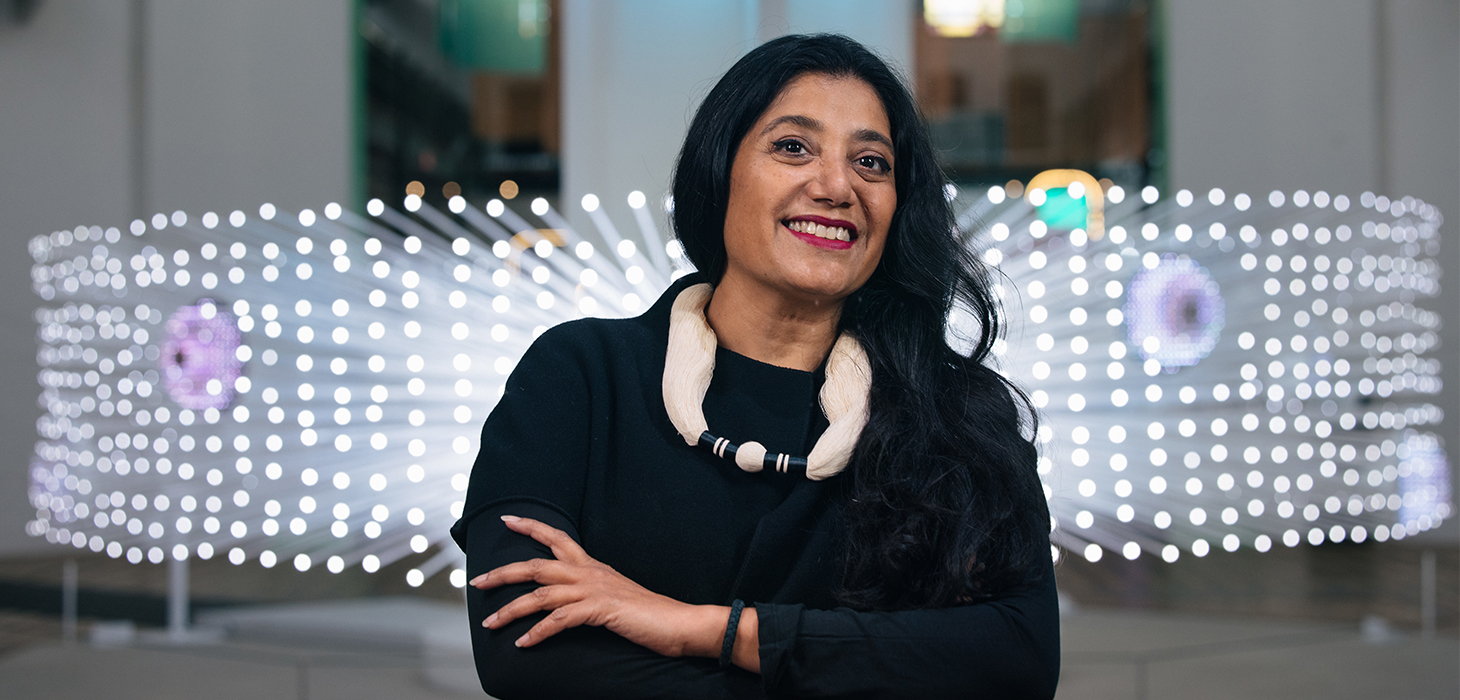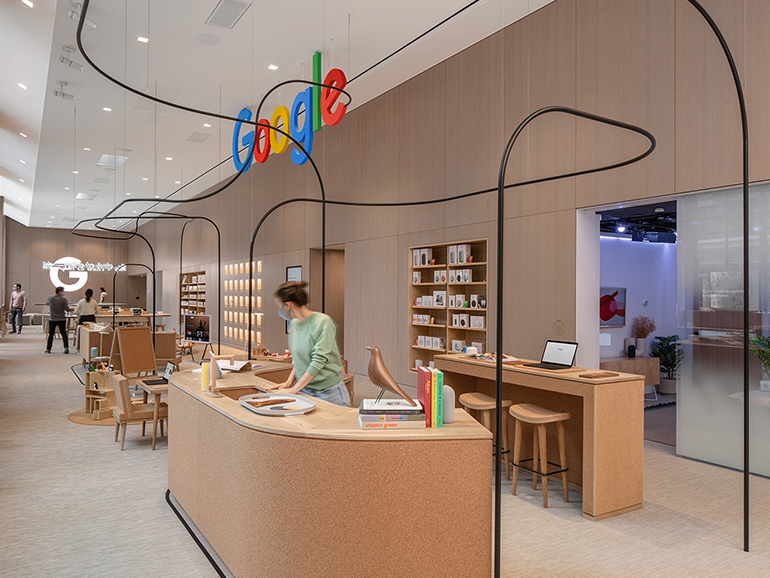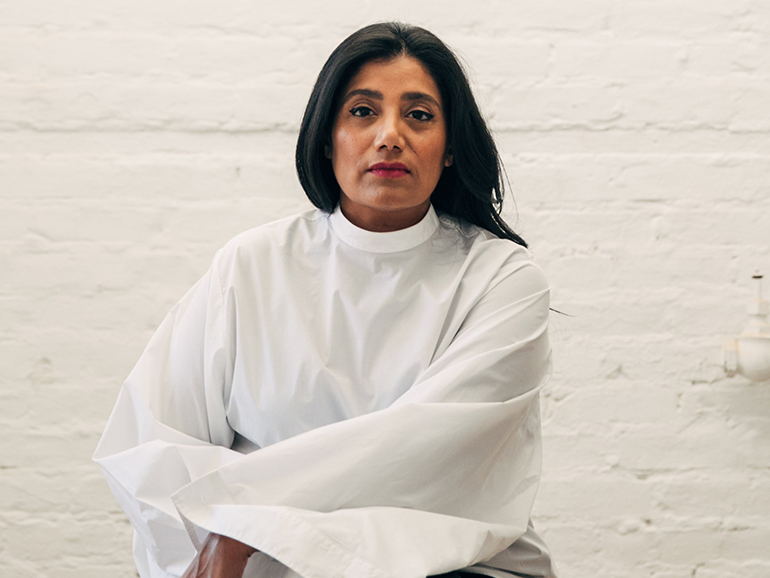Alumna making waves with design in New York City

The pandemic did little to slow down Suchi Reddy.
The 1991 graduate from the School of Architecture & Community Development is receiving wide acclaim for two very different high-profile design projects – both developed during the pandemic – that have earned her praise and showcase in the New York Times for the innovative way they blend art, design and technology.
The first of those projects by Reddy and her company, Reddymade Architecture and Design, was the first flagship store for Google in New York City, which opened during the summer of 2021.
She followed that by designing a sculptural piece, “me + you” that was featured in the famous rotunda of the Smithsonian Arts and Industries building in Washington D.C., as part of the Smithsonian Institution’s 175th anniversary celebration, called “Futures.”
“When the pandemic broke out, we worked through the pandemic on two very important projects, both to do with technology, but in rather different ways,” Reddy said. “Google has never had a store before and we were the first to imagine what that might look like and we designed it almost as the anecdote to a tech experience where it’s meant to be warm, welcoming and full of wonder.”
 Reddy’s “me + you” design was inspired by many different passions, including artificial intelligence and machine learning, vibration, light, sound and neuroscience. The design shone brightly in the same spot that once featured Charles Lindbergh’s plane, Thomas Edison’s lightbulb and where the historic first moonwalk was shown.
Reddy’s “me + you” design was inspired by many different passions, including artificial intelligence and machine learning, vibration, light, sound and neuroscience. The design shone brightly in the same spot that once featured Charles Lindbergh’s plane, Thomas Edison’s lightbulb and where the historic first moonwalk was shown.
“Mostly I was inspired by the idea of technology giving people a voice and I wanted to think about this idea of how to give people a voice and express it in light,” she said. “I came up with the idea of taking a vibration of sound and turning it into a vibration of light and asking people to express their visions of the future into the sculpture. So that it could learn, adapt and reinterpret their vision back to them and also show them how their individual vision was affecting the collective vision.”
Reddy credits her fondness for architecture and design all the way back to a young age in her native India. She cultivated her passion by way of her parents, most notably her mother, who helped design the unique home they lived in, which was highly influenced by Japanese architecture.
“I had this sort of epiphany that my house was making me a different person than my friends,” Reddy said. “Not better, not worse, just different. I knew that it affected me and in essence architecture has always been a protagonist in the story of my life.
“It has shaped me. And from that sort of early epiphany, I was really driven to become an architect. When I look back on it, I had a fairly unusual and rich introduction to architecture, which then made me want to be an architect.”
While Reddy’s architecture dream was born in India, it was pursued and honed in the United States at University of Detroit Mercy, following her immigration to the country and ultimately, Detroit.
Reddy, looking to further her architectural education, soon found herself calling Detroit Mercy and the School of Architecture home.
“I think one of the most amazing things about Detroit is that it is such a unique city in all of America,” Reddy said. “It has this incredible sense of history, it’s the seat of essentially a revolution in how we saw our world. I really reacted extremely positively, I was incredibly inspired by Detroit.”
The University, the city and the School of Architecture left a lasting impression on Reddy as she prepared for her career in architecture.
“Being in a school of architecture, I think one of the things I found very beautiful about it was kind of this sense of collaboration that I found there, both with my fellow students and the introduction to studying among various disciplines because my philosophy classes, for instance, made a huge impression on me as did my history of art class and this was slightly a different way of being educated versus what I was used to,” she said. “I really had a beautiful introduction to a country and sort of see my time in Detroit as really understanding what an ethos of a place might be and how architecture could actually contribute to shaping that.”
 Following her education at Detroit Mercy, she moved around the country working for various firms from Florida to Oregon to Wisconsin, before eventually landing in New York City.
Following her education at Detroit Mercy, she moved around the country working for various firms from Florida to Oregon to Wisconsin, before eventually landing in New York City.
Once there, she established her own firm. She grew Reddymade Architecture and Design from a one-person firm in 2002 to employing nearly 20 today.
“I was working for Michael Gabellini, who I consider one of my mentors, and they had just had to downsize and the same day, somebody called me and had asked if I would design a house. That’s kind of how I began working for myself,” she said. “It was not a plan, it grew rather organically, so I began making my projects myself and in the process of designing that house, which never got built, I met some other people who introduced me to other clients.”
Reddy, who serves on the Dean’s Board of Advisors for the School of Architecture & Community Development at Detroit Mercy, reiterated how important the University was in her development and thinking about architecture.
It’s now reflected in her work and her company’s work.
“Part of Detroit Mercy’s lasting legacy in my work is that while I was there, I also developed or had the chance to develop my interest in contemporary art,” she said. “I read every art book that I could lay my hands on. My work was influenced by it, if not so much by the architecture, in the very least in the thinking behind what makes something useful, what makes it unique, what makes it a contribution.
“I think that design exists in everything; it’s not restricted to architecture or to language. I like to celebrate its presence in everything I do. The projects we take on and the portfolio of the firm is incredibly diverse, which makes it a rather difficult practice to explain to clients because generally people want to see you’ve done one thing and 30 of the same thing. We are always doing things that are different, innovative, where we value the thinking that we bring to the table. It’s also a very collaborative practice.”
While Reddy had an epiphany as a child in seeing her future as an architect, another impactful moment was witnessing 9/11 in New York City. It’s helped push her to where she is today.
“As traumatic a moment for all of us, it sparked thinking,” she said. “I took a bit of time then to really think about is being an architect what I really want to be? ‘Is this how I can contribute to the world?’
“After a few weeks, I came back to knowing that this is what I do to make the world a better place for other people and this is my medium. I have been attracted to it, lived in it, revisited it and invested in it.
“I think as an architect, that is a very important thing to keep in mind.”
Top photo by Alyssa Schukar, top side photo by Paul Warchol and bottom side photo by Chloe Horseman.
— By Adam Bouton. Follow Detroit Mercy on Facebook, LinkedIn, Twitter and Instagram. Have a story idea? Let us know by submitting your idea.
